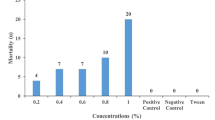Abstract
The present work had the objective of evaluating the influence of different concentrations of thymol on the biological parameters of engorged females of Rhipicephalus (Boophilus) microplus and also its ovicide activity on eggs of this tick. In order to carry out the work, four groups were formed, each containing 20 engorged females, which were immersed for 5 min in different concentrations of thymol (1.0%, 1.5%, and 2.0%) and a control group (water + dimethylsulfoxide). The following biological parameters were observed: initial weight (mg); egg mass weight (mg); pre-oviposition, oviposition, and survival period (days); hatching percentage (%HP); egg production (%EPI) and nutritional (%NI) indexes; and the percentage of control (%C). In order to perform the second stage, thymol solutions were sprayed on the egg masses (50 mg). The parameters’ initial weight and pre-oviposition did not present significant differences (p > 0.05) among the groups. Thymol caused alterations in the parameters egg mass weight, oviposition, survival period, hatching percentage, EPI, and NI, presenting highly significant differences between the treatments and the control group (p < 0.01). The control efficacy was higher than 95% in all the treatments, reaching 99% in the concentration of 2.0%. In the ovicide test, the hatching percentage was not affected in any of the treatments (p > 0.05). In the second experiment, when eggs were treated directly, the thymol did not affect significantly this parameter. These results demonstrate that thymol showed deleterious action on most of the analyzed parameters; thus, it is possible to conclude that, in laboratorial conditions, this monoterpene was efficient in the control of engorged females of R. (B.) microplus.

Similar content being viewed by others
References
Baladrin NF, Klocke JA, Wurtle ES, Bollinger WH (1985) Natural 259 plant chemicals: sources of industrial and medical materials. Science 228:1154–1660
Bennett GF (1974) Oviposition of Boophilus microplus (Canestrini, 1887) (Acarina: Ixodidae): influence of tick size on egg production. Acarol 16:52–61
Borges LMF, Carneiro JR, Gomes AG, Moreira PC (2001) Influência do peso inicial e da estação do ano na conversão em ovos de fêmeas de Boophilus microplus (Acari: Ixodidae). Cienc Animal Bras 2:127–131
Chagas ACS (2004) Controle de parasitas utilizando extratos vegetais. Rev Bras Parasitol Vet 13:156–160
Daemon E, Monteiro CMO, Rosa LS, Clemente MA, Arcoverde A (2009) Evaluation of the acaricide activity of thymol on engorged and unengorged larvae of Rhipicephalus sanguineus (Latreille, 1808) (Acari: Ixodidae). Parasitol Res 105:495–497
Drummond RO, Ernest SE, Trevino JL, Gradney WJ, Graham OH (1973) Boophilus anulatus and Boophilus microplus: laboratory tests of insecticides. J Econ Entomol 66:30–133
Ferreira P, Soares GLG, D'avila S, ECA BESSA (2009) The influence of caffeine and thymol on the survival, growth and reproduction of Subulina octona (BRUGÜIÈRE, 1789) (MOLLUSCA, SUBULINIDAE). Braz Arch Biol Technol 52(4):945–952
Furlong J, Martins JRS, Prata MCA (2004) Controle estratégico do carrapato dos bovinos. A Hora Vet 23:53–56
Furlong J, Martins JRS, Prata MCA (2007) O carrapato dos bovinos e a resistência: temos o que comemorar? Controle estratégico do carrapato dos bovinos. A Hora Vet 27:53–56
Grisi L, Massard CL, Moya-Borja GE, Pereira JB (2002) Impacto econômico das principais ectoparasitoses em bovinos no Brasil. A Hora Vet 21:8–10
Imdorf A, Kilchenman V, Bogdanov S (1995) Toxiziät von thymol; campher, menthol and eucaliptol auf Varroa jacobsoni oud ind Apis mellifera L. in labortest. Apidol 26:27–31
Jonsson NN, Piper EK (2007) Integrated control programs for ticks on catle, The University of Queensland, Queensland
Labruna MB (2008) Combate contra Rhipicephalus (Boophilus) microplus. In: Pereira MC, Labruna MB, Szabo MPJ, Klafke GM (eds) Rhipicephalus (Boophilus) microplus: Biologia, Controle e Resistência. MEDVET, São Paulo, pp 57–64
Mansour SA, Messehea SS, El-Gengaihi SE (2000) Botanical biocides. 4. Mosquitocidal activity of certain Thymus capitatus constituents. J Nat Toxins 9:49–62
Martins JRS, Furlong J, Leite RC (2006) Controle de carrapatos. In: Barros-Battesti DMB, Arzua M, Bechara GH (eds) Carrapatos de importância médico-veterinária da Região Neotropical. Um guia ilustrado para a identificação de espécies. Instituto Butantan, São Paulo, pp 145–153
Monteiro CMO, Daemon E, Clemente MA, Rosa LS, Maturano R (2009) Acaricidal efficacy of thymol on engorged nymphs and females of Rhipicephalus sanguineus (LATREILLE, 1808) (ACARI: IXODIDAE). Parasitol Res 105:1093–1097
Novelino AMS, Daemon E, Soares GLG (2007a) Evaluation of acaricide effect of thymol, menthol, salycilic acid and methyl salycilate on Boophilus microplus (Canestrini, 1887) (Acari: Ixodidae) larvae. Parasitol Res 101:809–811
Novelino AM S, Daemon E, Soares GLG (2007b) Avaliação da atividade repelente do timol, mentol, salicilato de metila e ácido salicílico sobre larvas de Boophilus microplus (CANESTRINI 1887) (ACARI: IXODIDAE). Arq Bras Med Vet Zootec 59:700–704
Pereira MC, Labruna MB (2008) Rhipicephalus (Boophilus) microplus. In: Pereira MC, Labruna MB, Szabo MPJ, Klafke GM (eds) Rhipicephalus (Boophilus) microplus: Biologia, Controle e Resistência. MEDVET, São Paulo, pp 15–56
Santos AP, Furlong J (2002) Competição intraespecífica em Boophilus microplus. Cienc Rural 32:1033–1038
Walker AR, Bouarttour A, Camicas JL, Estrada-Peña A, Horak I, Latif A, Pegram R, Preston P (2003) Ticks of Domestic Animals in Africa. A Guide to identification of Species. University of Edinburgh, Edinburgh
Author information
Authors and Affiliations
Corresponding author
Rights and permissions
About this article
Cite this article
de Oliveira Monteiro, C.M., Daemon, E., Silva, A.M.R. et al. Acaricide and ovicide activities of thymol on engorged females and eggs of Rhipicephalus (Boophilus) microplus (Acari: Ixodidae). Parasitol Res 106, 615–619 (2010). https://doi.org/10.1007/s00436-009-1709-1
Received:
Accepted:
Published:
Issue Date:
DOI: https://doi.org/10.1007/s00436-009-1709-1




